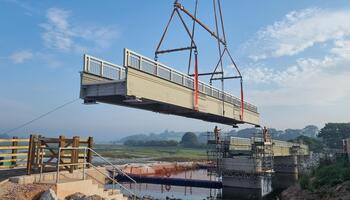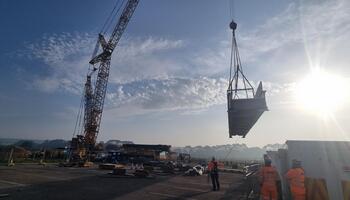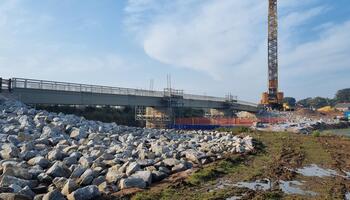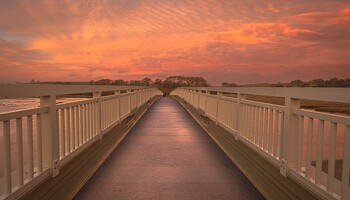Reference
COMPOSITE MATERIALS FOR THE
OTTER VALLEY ESTUARY FOOTBRIDGE
The Otter Valley Estuary Footbridge, a key element of the Lower Otter Restoration Project, marks significant progress toward climate adaptation and habitat restoration. Designed to restore the Otter River and its floodplain to their natural state, this innovative footbridge has become a focal point of environmental progress in the southwest of England.
THE IDEA
The 70 m long Otter Valley Estuary Footbridge in the southwest of England has to resist high demands. The footbridge is consistently designed for resilience and therefore consists of highly developed composite materials that have been carefully selected for their special properties. Developed in close collaboration with NOV Fiber Glass Systems UK, Kier and Cristex Composite Materials, these materials enable the bridge to withstand demanding loads. The carefully selected materials and precise engineering work together make the footbridge a special project.
TECHNICAL BENEFITS
- Enormous weight reduction
- Material with high compressive strength
- Corrosion resistance

Installation of the Otter Valley Estuary Footbridge

Installation of the Otter Valley Estuary Footbridge

Installation of the Otter Valley Estuary Footbridge

Otter Valley estuary footbridge at sunset
REINFORCING THIS IDEA
The technical advantages of this project are diverse and include a significant weight reduction, high compressive strength and corrosion resistance. SAERTEX's central role in this project was to specify and supply the key materials:
multiaxial glass fabrics (NCFs) and the innovative foam core
SAERfoam.
The focus remains on
SAERfoam, an ultra-lightweight foam with 3D glass reinforcements (PU/PE/PIR). This innovative hybrid core solution not only enables customizable mechanical properties, but also the creation of an exceptionally lightweight yet highly durable structure.
Manufactured using a precise vacuum infusion process, the footbridge consists of three sections and embodies the art of engineering and durability. The on-site assembly was carried out by the team from Kier and NOV Fiber Glass Systems UK.
THE SUCCESS STORY
On September 28, 2023, the Otter Valley Estuary footbridge reached a milestone: the tide returned under the bridge for the first time in over two centuries. This event not only underlines the engineering achievement, but also highlights its ecological significance. The bridge is an outstanding example of successful climate adaptation and habitat restoration.
Thanks to the effective teamwork among all project partners, the project was implemented quickly and successfully. Their expertise and involvement played a key role in ensuring the bridge's outstanding properties.
We are proud to contribute to projects that are not only technically brilliant, but also have a lasting environmental impact. True to our vision of "Innovation for a resource-saving future".